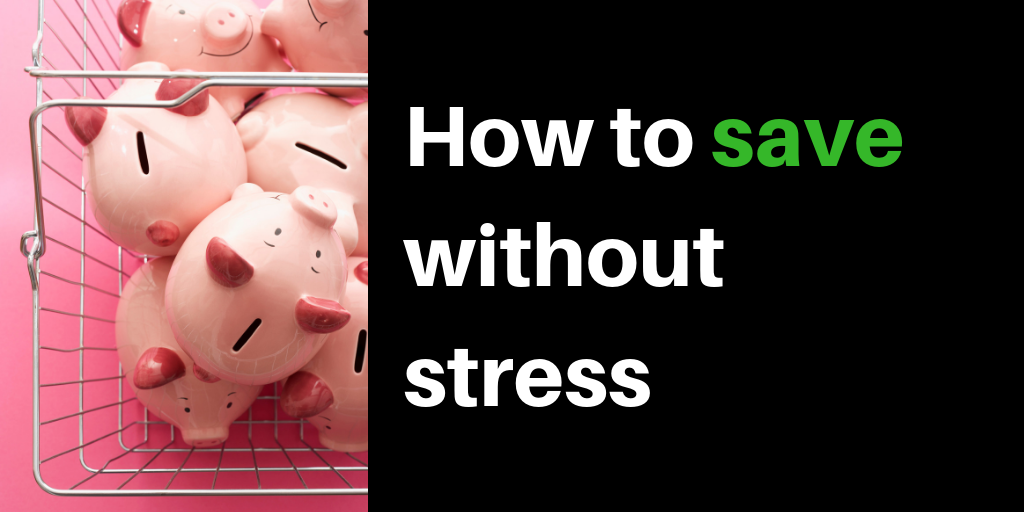How to save money is a popular question, and it’s sad that most answers leave people rolling their eyes and changing nothing.
The problem with most saving strategies is they’re hard work.
You have to think a lot.
You have to change habits.
Far better to have a saving strategy that doesn’t require you to think about it once it’s in place.
Here’s how to do it:
- Set your end Goal – why are you saving?
- Set your Rate – how much will you save?
- Automate paying yourself first – schedule bank transfers
- Isolate your savings – make the saving account hard to get to
- Celebrate – when you reach a goal, reward yourself!
Most saving strategies are hard work
Learning how to save money is not always intuitive.
The problem with most saving strategies is that they require you to think – a lot.
You have to put your past spending under the microscope. Budgets are often involved; sometimes you even need a spreadsheet. You have to change ingrained habits. You have to keep reminding yourself why you’re doing this. Just like weight loss, motivation is essential to maintain most saving methods.
Frankly, it’s exhausting.
Ultimately, that’s why a lot of people give up.
Which sucks, because without savings, you’re in for a rough ride.
Why you need to learn how to save money
Saving is one of the two rules of financial independence.
Without saving, two things eventually happen:
1. Something goes wrong
A ‘rainy day’ shows up. You get sick, your child gets sick, you lose your job, you get divorced, your car breaks down, you learn your insurance is inadequate after your house burns down. Basically, the proverbial hits the rotating blade.
Without a nice, cushy wad of savings – a buffer fund – you’re in a pickle. You have to either:
- make serious lifestyle changes,
- sell your stuff to cover the costs, or
- you end up in debt.
None of these is good news, especially if you’re already under the stress of a major event.
We all think it won’t happen to us, but frankly it’s just a matter of time. Whether it’s tomorrow or in 20 years, a buffer fund of savings will cushion the blow of the shocks of life.
2. You don’t buy assets
Buying assets is the second rule of getting to financial independence – that awesome point at which working becomes a choice rather than a necessity, because your assets are paying you an income.
Without savings, you’ll need debt to buy the income-producing assets that replace your work earnings. That’s a risky approach unless you know exactly what you’re doing and have a reliable crystal ball to predict what’s going to happen in the economy. The latter hasn’t been invented yet. Caveat: Bridgewater appears to have come close – though you’ll need $5 BILLION in assets to join their fund and find out.
No assets
= no passive income
= work till you can’t
= live on pension ($454/wk) + whatever superannuation you’ve got.
Not a recipe for a comfortable life.
Fortunately, saving CAN be simple. Yes, even if you’ve never been able to do it before.
Enter the Pay Yourself First Strategy
This saving method is about making the decisions once, putting steps in place to make those decisions happen without having to think about it again, and then watching your savings pile up.
Paying yourself first (or saving) is exactly as described on the label. You pay yourself first by putting savings away the moment you get any money in your hot little hand. You do it in such a way that you don’t even have to think about it – it’s all automated, it just happens, and – this is the clincher – it’s hard to stop it happening.
I’d call it fool-proof, but they keep making better fools 😉
Where it came from
I’ve been saving 50% of everything dollar I’ve received since I was 10 years old, since my mum first communicated the importance of saving to me.
But it hasn’t always been easy.
I began like most popular saving strategies suggest: for every dollar that came in (birthday and Christmas money mostly when I was 10, plus some pocket money from chores), I’d split it in two. Half went into savings, half to spending. I could use the ‘spend’ pile for whatever I wanted – donations included.
I’ve always been a bank account kind of gal rather than piggy bank or jam jar – having physical cash means I was missing out on interest, which seemed silly. I tracked my savings account balance on a chart instead.
Problem was, each time money came in, I had to do something with it. I had to make a choice. Yes, I had a well-ingrained habit, but as my engineering studies and work has taught me: whenever a human decision is required, risk management tells us to assume 100% failure rate of the human. In other words, the human will eventually get it wrong.

Don’t make me think!
Which is why Trump having access to nuclear codes is terrifying – seems like the probability of error went up when he came in!
As my professional change management skills grew through work, I saw that my personal approach to saving was poorly designed. It was taking up my mental space. I decided to apply what I’d learned as an engineer and consultant: I automated the process, and make it really hard to circumvent.
And that’s what I teach people to do now.
The power of this process is that it’s mostly a once-off affair. You do all the thinking up front, put your automations in place, and forget about it.
Sound good? Let’s get started:
Step 1: Set your end Goal
Motivation is powerful. There’s a good reason it works, and it’s to do with your brain.
I’m one of the least ‘woo woo’ people you’ll meet. I’m logic, maths and science aaaaallll the way. But I still recommend having a firm mental picture in your mind, because your brain is wired to seek out whatever you’ve planted in there.
That’s why the world suddenly seems full of babies and pregnant women when you decide to have a baby. Your brain is focused on it, so that’s what it sees, and that’s what it wants.
So why not give your brain a helping hand? Program it to focus on achieving something you want, whether that’s:
- A thing you want to buy or have, or
- A feeling you want to experience (e.g. the freedom that comes with independence)
If you can make it visual and put it somewhere you’ll see every day – even a post-it on your fridge would do – so much the better.
Step 2: Set your Rate
How much will you save?
This could be:
- a percentage, e.g. ‘I will save 20 cents of every dollar I receive.’, or
- an amount, e.g. ‘I will save $100 per week.’
…it’s up to you.
Side note: I’m often asked ‘How much should I save?’ My answer is: ‘As much as you possibly can.’ For guidance:
- 10% is OK,
- 20% is good,
- 50% is outstanding, and
- 70% would make you a medalist at the saving Olympics.
Be ambitious with your saving goal. After all, you can always get the money out of your savings account if you need to, but once it’s spent, it’s gone forever.
Step 3: Automate
Ever tried the ‘I’ll save what’s left over’ approach? Most of the time, it fails miserably and nothing is saved.
This is just human nature. We push the limits on everything. If there’s money in our wallets, we want to spend it to get the endorphin hit that results. Spending is drug-like in that way.
So, let’s circumvent our known weaknesses!
Let’s make saving the first thing we do instead of the last. Better yet, let’s make it so we don’t have to do anything to make it happen (after the first time, that is).
Here’s the process:
- If you don’t already have one, set up an online bank account that you’ll use for saving (more on this in the following step, but please pick one with no fees and that pays interest),
- Work out which day you get paid – is it Monday every week? Or the first day of each month?
- The day following your pay-day, schedule an automatic transfer that moves your saving amount (based on your rate) into the dedicated saving account.
Voila! All sorted.

Let’s avoid having buckets of money we have to sort manually – an automated strategy works a treat!
What if I don’t have a predictable pay cycle?
If you don’t have a regular pay-day, or you get paid in cash, you’ll need to do this manually. Which kind of sucks, because that’s where you’ll have opportunity to forget. So, put in place reminders that will help you remember, such as:
- a note in your wallet,
- an alarm or event on your phone, e.g. if you get a shift on Sunday evening and you know you’ll get cash then, book 30 mins to visit the bank on Monday to make a deposit on your phone, and/or
- a sticky note next to your computer or on the fridge.
It’s not fool-proof, but if it helps, it’s worth it.
Step 4: Isolate
Now the kicker – we need to make these savings as hard to get to as possible, so yielding to temptation will require a lot of effort.
The best way to do that? Make it REALLY HARD to get to your savings.
This is most easily done by:
- disconnect the account from any cards and online banking systems like PayPal, and
- have the account removed from your online banking portal.
That way, if you really want to get some of your savings out, you’ll have to physically go into a branch to withdraw from the account. I’m hoping that the effort required is enough to put you off the idea that required the money in the first place. Or, at the very least, it acts as a circuit-breaker when the instant gratification urge strikes – perhaps in the time it takes you to walk to the bank, you’ll have reconsidered your need to spend.
Though, of course, we must spend occasionally. Which brings us to…
Step 5: Celebrate!
Saving isn’t satisfying for everyone immediately. We’re wired to reward spending with a hit of endorphins that make us feel good. Spending, in other words, is a drug.
To make saving feel satisfying, we need to rewire ourselves.
One way to do this is through strategic celebration.
You could:
- Set saving milestone goals that allow for some splurge spending, e.g. If I hit a $10,000 savings account balance, I’ll treat myself to concert tickets.
- Set saving milestone goals to do something free (or cheap) and awesome as a reward, e.g. If I hit $10,000, I’m going to visit my favourite beach for a swim.
- Use the cognitive control theory in David Levin’s Raise Your Inner Game <LINK>, by tracking whether you saved each day/week/month with a tick-list on your fridge.
- Set your saving goal on stickk.com, with a threat to give some money to an organisation you hate if you don’t reach it – THEN celebrate when you don’t end up giving money to the NRA, or whatever org you’re anti.
Next steps
Now you know the theory of how to save money, it’s time to put it into practice:
- Set your end Goal – why are you saving?
- Set your Rate – how much will you save?
- Automate paying yourself first – schedule bank transfers
- Isolate your savings – make the saving account hard to get to
- Celebrate – when you reach a goal, reward yourself!
Got a saving goal you’d like to make public? Or a great idea for a reward when you’ve hit a specific goal? Leave a comment below and let us know!
What comes next?
Download our Free Financial Resources
Find the right Money School Course for you
Get the Book: Money School, Become Financially Independent and Reclaim Your Life, Lacey Filipich
Got a question: Contact Us
Lacey Filipich is the co-founder and director of Money School. She helps parents raise financially savvy kids and helps adults get on top of their finances. Connect with her on LinkedIn and follow the Money School Facebook page to learn more.


Thank you! I enjoy reading your articles. Your personality shines through and the advice is very simple and easy to implement. I really like the concept of ‘Strategic celebration’. Im going to add one of those to my calendar to mark a completed savings goal.
Thrilled to hear it Sarah 🙂 Thanks for reading, and thanks for the comment – enjoy your strategic celebration!
I really wanted to save money, but I could not. I found your tips really helpful and I think now I will be able to save some money.
Thanks for your amazing article.